November 21, 2009
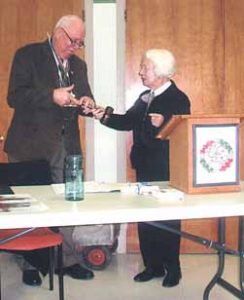
At the Annual General Meeting, after election of the new slate of officers, Lin Good passed the gavel to new president Dean Taylor. Several members then shared their family stories and showed treasured artifacts.
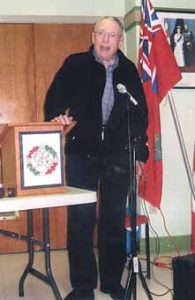 First was Terry Hicks, with a story of his father’s determination to have King George VI and Queen Elizabeth appear on the train platform at Watrous, Saskatchewan while their engine was stopped there during their cross-country trip in 1939. He was a school inspector who obviously cared about his scholars. Ottawa had refused his request, so he wrote directly to the King. He received a reply from the King’s secretary saying “Their Majesties will appear on the platform of the railway station there, and they will, of course, be glad to give the children of your district an opportunity of seeing them” … which did occur on 3 June 1939. Their Majesties were greeted by the major and about 10,000 students and people from the district. Terry added, “There was displeasure expressed by Ottawa on the direct intervention” taken by his father.
First was Terry Hicks, with a story of his father’s determination to have King George VI and Queen Elizabeth appear on the train platform at Watrous, Saskatchewan while their engine was stopped there during their cross-country trip in 1939. He was a school inspector who obviously cared about his scholars. Ottawa had refused his request, so he wrote directly to the King. He received a reply from the King’s secretary saying “Their Majesties will appear on the platform of the railway station there, and they will, of course, be glad to give the children of your district an opportunity of seeing them” … which did occur on 3 June 1939. Their Majesties were greeted by the major and about 10,000 students and people from the district. Terry added, “There was displeasure expressed by Ottawa on the direct intervention” taken by his father.
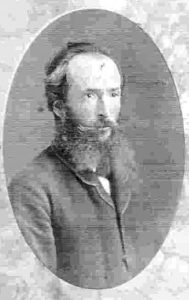
 Eva Wirth described finding snapshots which had adhered to cardboard, and were at the bottom of a box of photos she’d gone through many times, but when she inverted the box, they appeared. She carefully removed the photos from between the cardboard and a piece of plastic film. On turning over one of the photos, she read “William (Red Billy) Caverly” and realized she was looking at her 2-greats-grandfather — apparently so nicknamed because of his flaming red hair.
Eva Wirth described finding snapshots which had adhered to cardboard, and were at the bottom of a box of photos she’d gone through many times, but when she inverted the box, they appeared. She carefully removed the photos from between the cardboard and a piece of plastic film. On turning over one of the photos, she read “William (Red Billy) Caverly” and realized she was looking at her 2-greats-grandfather — apparently so nicknamed because of his flaming red hair.
Lynn Bell showed the “grandmother chest” he made for his granddaughter Lindsay. The artifacts added to the red oak chest include copies of an ancestor’s headstone, letters, historical papers, pictures of 12 great grandmothers, spoons, and various other collectibles from his family’s past. The first names of Lindsay’s female ancestors are inscribed around the base of the chest, with small Loyalist flags above the appropriate names.
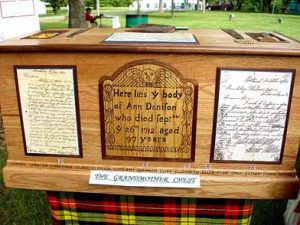
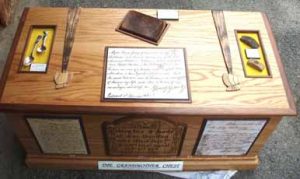
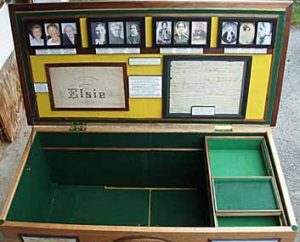
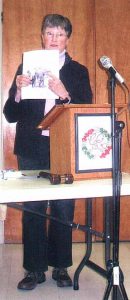 Mary Elizabeth Robb told of the schooner Garibaldi which set out from Fairhaven, NY in November 1880 with Captain William McGlenn at the helm. He put into Presqu’Ile but a headwind blew her across the lake, and the next day she was near Frenchman’s Bay, only eighteen miles east of Toronto. They once again sailed back to Presqu’Ile but in strong squalls the anchor cable parted and her hold flooded. Two ships tried to rescue the crew. As night fell, a lifeboat managed to rescue part of the Garibaldi‘s crew but the captain, male and one sailor were left on board. By morning, calmer seas prevailed but one of the men had perished, and Captain McGlenn had lost consciousness. He gave up sailing and opened an inn at Hamilton.
Mary Elizabeth Robb told of the schooner Garibaldi which set out from Fairhaven, NY in November 1880 with Captain William McGlenn at the helm. He put into Presqu’Ile but a headwind blew her across the lake, and the next day she was near Frenchman’s Bay, only eighteen miles east of Toronto. They once again sailed back to Presqu’Ile but in strong squalls the anchor cable parted and her hold flooded. Two ships tried to rescue the crew. As night fell, a lifeboat managed to rescue part of the Garibaldi‘s crew but the captain, male and one sailor were left on board. By morning, calmer seas prevailed but one of the men had perished, and Captain McGlenn had lost consciousness. He gave up sailing and opened an inn at Hamilton.
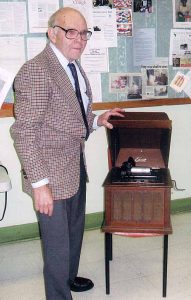 John Buck brought a Victrola given to him by his father before 1944. He has a collection of 100 cylinders, including a First World War ditty, “Bing, Bang, Bing’em on the Rhine” – presumably a play on the name of Lord Byng, the commander at Vimy Ridge.
John Buck brought a Victrola given to him by his father before 1944. He has a collection of 100 cylinders, including a First World War ditty, “Bing, Bang, Bing’em on the Rhine” – presumably a play on the name of Lord Byng, the commander at Vimy Ridge.
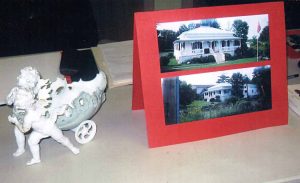 Philip Smart brought pictures of his beautifully restored 1851 old mill regency cottage, once rented by Byron Derbyshire and his wife Alice (nee Timmerman) from Arnold Booth, grandson of Benjamin Booth, U.E., a grist miller. Their daughter Harriet Derbyshire was married in the parlour of this house to Edwin Smart of Brockville; they are Philip’s grandparents. The rare china carriage came from them.
Philip Smart brought pictures of his beautifully restored 1851 old mill regency cottage, once rented by Byron Derbyshire and his wife Alice (nee Timmerman) from Arnold Booth, grandson of Benjamin Booth, U.E., a grist miller. Their daughter Harriet Derbyshire was married in the parlour of this house to Edwin Smart of Brockville; they are Philip’s grandparents. The rare china carriage came from them.
November photos courtesy Peter Davy, UE
October 3, 2009
 During the business meeting preceding the program, Genealogist Eva Wirth announced that six members had been approved for U.E. certificates:
During the business meeting preceding the program, Genealogist Eva Wirth announced that six members had been approved for U.E. certificates:
Janet Lynn Smith, whose Loyalist ancestor is Lt. Henry Simmons; Lewis Eugene Willis who descends from Paul Comer; James Gordon Keller, Christian Michael Keller, and Reta Irene Keller who claimed Loyalist status through Johann Jacob Powley; and William Logan Beeman whose ancestor was Sgt. James McKim.
Left: President Lin Good, William Logan Beeman, Genealogist Eva Wirth.

About 35 members and visitors were then addressed by Sue Bazely, Executive Director of the Cataraqui Archaeological Research Foundation. Sue spoke about the three versions of Fort Frontenac that preceded the present building on Ontario Street. She illustrated her talk with plans of the various forts, and photographs taken during several successive excavations, as well as documents from the French period of residence in the fort.
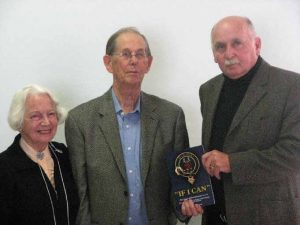 William Cowan, seen here with President Good and Librarian John Chard, generously presented the branch library with a copy of his new book, ” If I Can” : The Story of David Cowan, R.N., U.E. Incidentally, congratulations were expressed to John Chard, the 2009 recipient of the Dorchester Award given for “outstanding volunteerism in the United Empire Loyalists’ Association of Canada”. We all concur that it was well-deserved.
William Cowan, seen here with President Good and Librarian John Chard, generously presented the branch library with a copy of his new book, ” If I Can” : The Story of David Cowan, R.N., U.E. Incidentally, congratulations were expressed to John Chard, the 2009 recipient of the Dorchester Award given for “outstanding volunteerism in the United Empire Loyalists’ Association of Canada”. We all concur that it was well-deserved.
October 3 photos courtesy Fraser Carr, UE
May 11, 2009
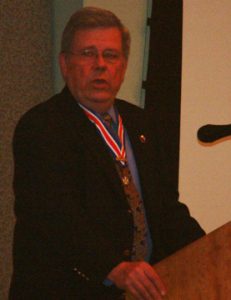 Over 60 members and guests gathered at the Donald Gordon Centre, Queen’s University to enjoy a fine dinner and socialize. Our special guest was Dominion President of the United Empire Loyalist Association of Canada, Frederick H. Hayward, UE. Mr. Hayward is the 35th President of the UELAC.
Over 60 members and guests gathered at the Donald Gordon Centre, Queen’s University to enjoy a fine dinner and socialize. Our special guest was Dominion President of the United Empire Loyalist Association of Canada, Frederick H. Hayward, UE. Mr. Hayward is the 35th President of the UELAC.
Fred spoke about some of the issues currently occupying the Association, such as the need for improving Canadians’ understanding of who the Loyalists were and their importance in establishing this country. He also spoke about “connections” — how we find inter-connections among Canadians from coast to coast to coast, because of our Loyalist heritage. He mentioned his own connection with this part of Ontario, due to his descent from Philip Embury, one of the founders of the Methodist Church in the Thirteen Colonies. Philip died before the American Revolution, in 1773, but his brother’s family settled in Ontario after the war. Philip’s son Samuel lived for about fifteen years in Augusta Township (Grenville County) before moving back to St. Armand, Quebec, to be near his wife’s family.
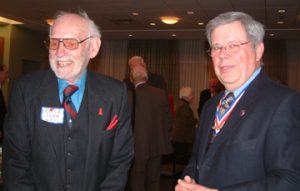 Ross Long, UE, was pleased to inform President Hayward that three generations of his family were present at the dinner. Ross’s son Jim Long is the current chair of the branch House committee.Fred says he is enjoying the opportunity during his presidency to visit UELAC branches across the country and speak with members. He obviously enjoys listening to the views of young and old alike. And Kingston Branch enjoyed having him visit!
Ross Long, UE, was pleased to inform President Hayward that three generations of his family were present at the dinner. Ross’s son Jim Long is the current chair of the branch House committee.Fred says he is enjoying the opportunity during his presidency to visit UELAC branches across the country and speak with members. He obviously enjoys listening to the views of young and old alike. And Kingston Branch enjoyed having him visit!
January 24, 2009

Mary Gilbert arrives photos courtesy Patricia Kempson
Nancy Cutway’s advertised talk on “Researching Loyalist Women” turned out to be a ruse: instead, Nancy appeared in the persona of her 5-greats-grandmother Mary Rowland Gilbert (1754-1822). “Mary” spoke of her life in Ridgefield, Connecticut prior to the revolution. She related some of her husband’s activities in the Queen’s Rangers during the American Revolution, their life in New Brunswick from 1793 to 1799, and then coming to Upper Canada when their beloved regimental colonel, John Graves Simcoe, returned to Canada to be the first governor of the separate province of Upper Canada. A good number of soldiers from the Queen’s Rangers moved en masse from New Brunswick to settle in Norfolk County, around the newly-created town of Simcoe.
 “Mary” wore a dress of linen and wool, known as linsey-woolsey, which Nancy wove and sewed for herself in preparation for the 1984 Loyalist Bicentennial celebrations. She demonstrated that her pockets were separate sacs, tied around the waist and worn inside her dress and underskirts, next to the “shift” — the bottom layer, which also doubled as a nightdress in Loyalist times. In that way, the wearer could feel the pocket against her body, and would be aware of someone attempting to reach through the side openings of her dress, in order to pick her pocket! The carrying of a purse or “pocketbook” developed at a later date.
“Mary” wore a dress of linen and wool, known as linsey-woolsey, which Nancy wove and sewed for herself in preparation for the 1984 Loyalist Bicentennial celebrations. She demonstrated that her pockets were separate sacs, tied around the waist and worn inside her dress and underskirts, next to the “shift” — the bottom layer, which also doubled as a nightdress in Loyalist times. In that way, the wearer could feel the pocket against her body, and would be aware of someone attempting to reach through the side openings of her dress, in order to pick her pocket! The carrying of a purse or “pocketbook” developed at a later date.
Nancy cited the three-volume work by Murtie June Clark, Loyalists in the Southern Campaign of the Revolutionary War (Genealogical Publishing Co., 1991) as most helpful in developing her presentation, along with family documents. This collection of muster lists permitted identification of when and where Mary’s husband, Sgt. Isaac Gilbert, was serving, sick at home or prisoner, at each quarterly muster taken through the revolution.
